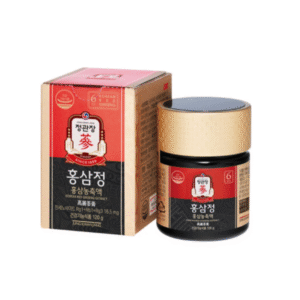❤️ Introduction
High cholesterol is one of the most common risk factors for cardiovascular disease — a leading cause of death worldwide. Excessive levels of LDL (bad cholesterol) and triglycerides can clog arteries, leading to atherosclerosis, hypertension, and heart attacks.
While medication such as statins are often prescribed, many people seek natural, complementary solutions that support heart and lipid health without harsh side effects. One of the most studied herbal options is Korean Red Ginseng (Panax ginseng C.A. Meyer) — a traditional root known for centuries in Korean medicine for improving vitality, stamina, and circulatory balance.
Modern science now confirms that Korean Red Ginseng can help regulate cholesterol levels, improve lipid metabolism, and protect heart function through multiple biological mechanisms.
🔬 1. The Science Behind Ginseng’s Cholesterol-Lowering Effects
The active components of Korean Red Ginseng, known as ginsenosides, are responsible for its lipid-regulating effects. Among the most studied are Rb1, Rg3, and Rh2, which influence how the liver produces and processes fats.
Research shows that these ginsenosides:
- Reduce total cholesterol and LDL-C by inhibiting the enzyme HMG-CoA reductase, the same target as statin drugs.
- Increase HDL-C (good cholesterol), improving lipid ratios.
- Enhance lipid oxidation, helping the body burn fat more efficiently.
- Prevent lipid peroxidation, a process that leads to plaque buildup in arteries.
A 2020 study published in Phytotherapy Research found that adults taking 2 grams of Korean Red Ginseng extract daily for 8 weeks experienced significant reductions in total cholesterol and LDL levels compared to placebo, without any adverse effects.
🫀 2. Improving Blood Lipid Profile and Arterial Health
High cholesterol often leads to arterial stiffness and impaired endothelial function (the ability of blood vessels to expand). Korean Red Ginseng has been shown to improve vascular flexibility by enhancing nitric oxide (NO) production — a molecule that relaxes blood vessels and promotes healthy circulation.
A Journal of Ginseng Research (2019) clinical trial demonstrated that ginseng supplementation improved arterial compliance and reduced oxidative stress markers in subjects with mild hyperlipidemia (high lipid levels).
This dual action — improving both lipid metabolism and vascular elasticity — makes Korean Red Ginseng a natural ally in preventing atherosclerosis and improving cardiovascular resilience.
🩸 3. How Ginseng Helps Manage Triglycerides and Fat Metabolism
Triglycerides are another key factor in cardiovascular risk. Elevated levels often result from poor diet, stress, or insulin resistance.
Korean Red Ginseng helps manage triglyceride levels by:
- Enhancing lipid breakdown (lipolysis) in liver and muscle tissue
- Supporting insulin sensitivity, which reduces fat storage
- Balancing blood sugar levels, indirectly improving lipid metabolism
A 2021 review in Nutrients found that Korean Red Ginseng reduced triglyceride levels by up to 15% in participants with metabolic syndrome, while also improving HDL cholesterol and lowering inflammation-related biomarkers such as C-reactive protein (CRP).
⚖️ 4. Combating Oxidative Stress and Arterial Inflammation
One reason cholesterol becomes harmful is when LDL oxidizes — triggering inflammation and plaque formation. Ginseng’s antioxidant and anti-inflammatory compounds help block this process.
Ginsenosides and polyphenols from Korean Red Ginseng:
- Neutralize free radicals that oxidize LDL cholesterol
- Inhibit NF-κB and COX-2 enzymes, reducing vascular inflammation
- Support detoxification enzymes in the liver, improving lipid clearance
Over time, these effects reduce arterial inflammation and improve overall vascular integrity, keeping the heart and blood vessels healthier.
💪 5. Supporting Liver Function and Lipid Regulation
The liver plays a central role in cholesterol production and breakdown. Korean Red Ginseng supports hepatic metabolism, improving how fats and toxins are processed.
Animal and human studies have shown that ginseng enhances AMP-activated protein kinase (AMPK) activity — an enzyme that promotes fat utilization and reduces lipid synthesis in the liver.
This mechanism mirrors how physical exercise improves metabolic balance, making red ginseng a beneficial complement for individuals with sedentary lifestyles or early metabolic disorders.
🌿 6. How to Use Korean Red Ginseng for Cholesterol Support
For cholesterol and lipid health, the recommended usage includes:
- Standardized extract (4–8% ginsenosides): 200–400 mg daily
- Powder or capsule: 1–2 grams daily
- Tea or tonic: 1–2 cups daily for mild cases or general prevention
Best taken consistently for at least 6–8 weeks.
It can be combined with omega-3 fatty acids, garlic extract, or green tea for synergistic lipid-lowering effects.
⚠️ Note: Individuals taking statins, anticoagulants, or diabetes medication should consult their healthcare provider before use.
💠 7. Long-Term Benefits for Cardiovascular Health
Regular Korean Red Ginseng consumption supports:
- Lower total cholesterol and triglycerides
- Higher HDL cholesterol levels
- Reduced arterial inflammation
- Improved circulation and heart endurance
These cumulative effects make Korean Red Ginseng one of the best natural options for maintaining balanced lipids and a strong, healthy heart.
❤️ Conclusion
Korean Red Ginseng offers a natural, research-backed approach to managing cholesterol and improving cardiovascular health.
Its unique ginsenosides not only help balance lipid levels but also protect arteries, improve circulation, and enhance metabolic efficiency.
When used regularly and combined with a healthy diet and exercise, Korean Red Ginseng can serve as a powerful adjunct to modern heart care — promoting balance, longevity, and vitality from within.
🇰🇷 Premium Korean Ginseng Online Shop







